Allergy
- Page Path
-
- HOME
- TOPICS
- Allergy
- Topics
-
- Adolescence Medicine (3)
- Allergy (52)
- Cardiology (76)
- Critical Care Medicine (8)
- Developmental and Behavioral Medicine (17)
- Emergency Medicine (5)
- Endocrinology (51)
- Gastroenterology (57)
- General Pediatrics (37)
- Genetics and Metabolism (20)
- Hematology (11)
- Immunology (12)
- Infection (66)
- Neonatology (Perinatology) (107)
- Nephrology (Genitourinary) (49)
- Neurology (88)
- Nutrition (25)
- Oncology (15)
- Neurobehavior (11)
- Pulmonology (26)
- Rheumatology (2)
- Other (29)
- Original Article
- Allergy
- Asthma predictive index as a useful diagnostic tool in preschool children: a cross-sectional study in Korea
- Dong Hyeon Lee, Ji-Won Kwon, Hyung Young Kim, Ju-Hee Seo, Hyo-Bin Kim, So-Yeon Lee, Gwang-Cheon Jang, Dae-Jin Song, Woo Kyung Kim, Young-Ho Jung, Soo-Jong Hong, Jung Yeon Shim
- Clin Exp Pediatr. 2020;63(3):104-109. Published online November 8, 2019
-
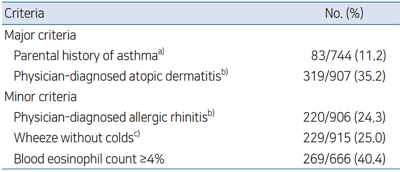
Question: Is physician-diagnosed current asthma in preschool children associated with the asthma predictive index, atopic sensitization, or pulmonary function test?
Finding: Physician-diagnosed current asthma in preschool children was associated with the asthma predictive index, but not with spirometry, methacholine provocation test, fractional expiratory nitric oxide level, and atopic sensitization.
Meaning: Physician-diagnosed asthma in preschool children may be different from classic atopic asthma in school children or adolescents.
- Editorial
- Allergy
- Is the predictive model for asthma development useful as a tool for diagnosing pediatric asthma?
- Bong-Seong Kim
- Clin Exp Pediatr. 2020;63(3):102-103. Published online February 5, 2020
-
- Clinical Note
- Allergy
- Complement 4 levels of a 4-year-old girl with angioedema
- Soyoung Shin, Yoon Tae Lee, Kyung Yil Lee, Joonhong Park, Jae Ho Lee, Eun Ae Yang
- Clin Exp Pediatr. 2020;63(1):30-31. Published online November 8, 2019
-

- Editorial
- Allergy
- Hereditary angioedema in childhood
- Young Min Ahn
- Clin Exp Pediatr. 2020;63(1):18-19. Published online January 15, 2020
-
- Perspective
- Allergy
- Food allergy and food-induced anaphylaxis in children: an increasing critical public health issue
- Sooyoung Lee
- Clin Exp Pediatr. 2019;62(12):431-432. Published online November 12, 2019
-
- Original Article
- Allergy
- Nasal eosinophilia and eosinophil peroxidase in children and adolescents with rhinitis
- Yeonu Choi, Haeun Jeon, Eun Ae Yang, Jong-Seo Yoon, Hyun Hee Kim
- Clin Exp Pediatr. 2019;62(9):353-359. Published online April 24, 2019
-
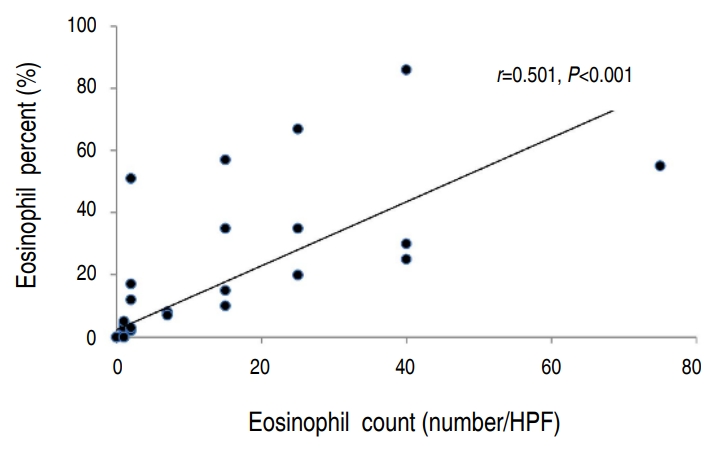
Background: Researchers have shown that eosinophil peroxidase (EPO) is a relatively accurate marker of eosinophilia and eosinophil activity. However, its use as a marker of eosinophilic inflammation in nasal secretions is limited because the diagnostic cutoff values of EPO for use as a one-time test for allergic diseases such as allergic rhinitis have not been established.
Purpose: To identify the correlation...
- Editorial
- Allergy
- Is determining nasal eosinophil count and nasal eosinophil peroxidase concentration clinically useful in children with rhinits?
- Bong Seok Choi
- Clin Exp Pediatr. 2019;62(9):342-343. Published online July 9, 2019
-
- Should partially hydrolyzed infant formula be given to the general infant population for the primary prevention of allergic disease?
- Tae Won Song
- Clin Exp Pediatr. 2019;62(9):340-341. Published online May 17, 2019
-
- Review Article
- Allergy
- Phenotypes of allergic diseases in children and their application in clinical situations
- Eun Lee, Soo-Jong Hong
- Clin Exp Pediatr. 2019;62(9):325-333. Published online April 23, 2019
-
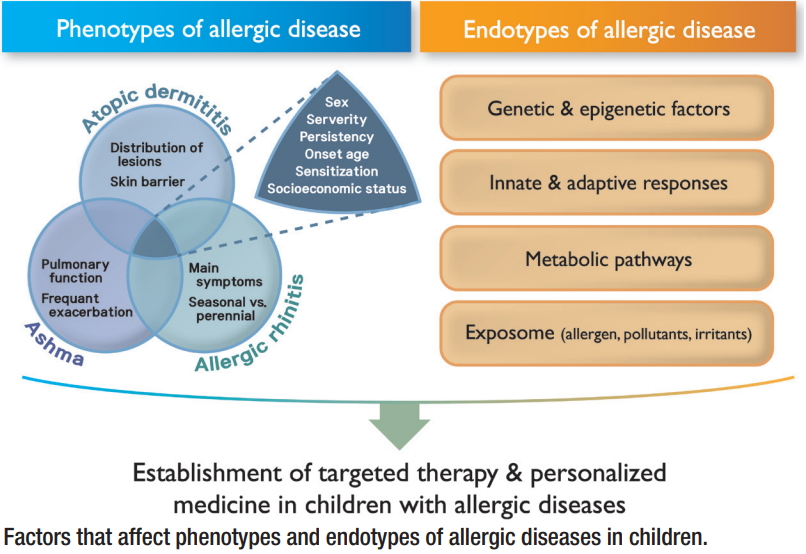
Allergic diseases, including allergic rhinitis, asthma, and atopic dermatitis, are common heterogeneous diseases that encompass diverse phenotypes and different pathogeneses. Phenotype studies of allergic diseases can facilitate the identification of risk factors and their underlying pathophysiology, resulting in the application of more effective treatment, selection of better treatment responses, and prediction of prognosis for each phenotype. In the early phase...
- Editorial
- Allergy
- Why should we monitor for hematologic adverse drug reactions to oxcarbazepine?
- Gwang Cheon Jang
- Clin Exp Pediatr. 2019;62(8):299-300. Published online June 24, 2019
-
- Case Report
- Allergy
- Drug eruption by antihistamine mistaken for chronic urticaria in a child
- Gun Moo Lee, Shou-Yu Chu, Sung Yeon Kang, Hyo-Bin Kim, Jin-Sung Park, Ja Kyoung Kim
- Clin Exp Pediatr. 2019;62(2):75-78. Published online October 30, 2018
-

Although rare, antihistamines can cause adverse effects, including drug-induced eruptions or anaphylaxis. A 4-year-old child visited the pediatric department of a hospital for skin eruptions after administration of antihistamines, (e.g., ucerax [hydroxyzine] or leptizine [levocetirizine]), for cholinergic rashes; he did not have pruritus. Skin prick, intradermal, and drug provocation tests were performed to determine the relationship between the antihistamines and...
- Review Article
- Allergy
- Particulate matter and childhood allergic diseases
- Song-I Yang
- Clin Exp Pediatr. 2019;62(1):22-29. Published online November 7, 2018
-

Particulate matter (PM) is a ubiquitous air pollutant that is a growing public health concern. Previous studies have suggested that PM is associated with asthma development and exacerbation of asthma symptoms. Although several studies have suggested increased risks of atopic dermatitis, allergic rhinitis, and allergic sensitization in relation to PM exposure, the evidence remains inconsistent. The plausible mechanisms underlying these...
- Original Article
- Allergy
- Common features of atopic dermatitis with hypoproteinemia
- So Yoon Jo, Chan-Ho Lee, Woo-Jin Jung, Sung-Won Kim, Yoon-Ha Hwang
- Clin Exp Pediatr. 2018;61(11):348-354. Published online September 16, 2018
-
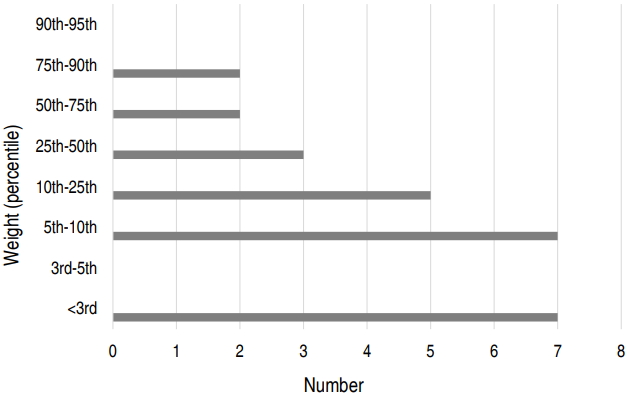
Purpose: The purpose of this study was to identify the causes, symptoms, and complications of hypoproteinemia to prevent hypoproteinemia and provide appropriate treatment to children with atopic dermatitis. Methods: Children diagnosed with atopic dermatitis with hypoproteinemia and/or hypoalbuminemia were retrospectively reviewed. The patients’ medical records, including family history, weight, symptoms, treatment, complications, and laboratory test results for allergies and skin cultures,...
- Case Report
- Allergy
- Breast abscess caused by
Staphylococcus aureus in 2 adolescent girls with atopic dermatitis - Sung Man Park, Won Sik Choi, YoonSun Yoon, Gee Hae Jung, Chang Kyu Lee, So Hyun Ahn, Yoon Wonsuck, Young Yoo
- Clin Exp Pediatr. 2018;61(6):200-204. Published online June 25, 2018
-
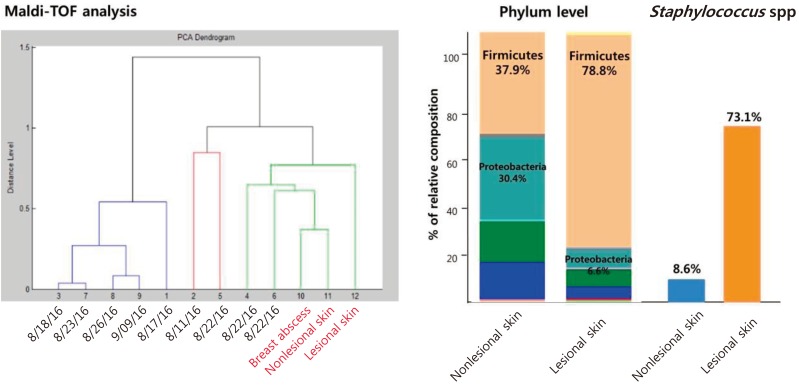
Atopic dermatitis (AD) is a chronic inflammatory skin disease in children. Patients with AD experience a high rate of colonization of the skin surface by
Staphylococcus aureus . Because of a skin barrier defect, there is a potential risk of staphylococcal invasive infection in patients with AD. Here, we present 2 cases of breast abscess caused byS. aureus in 2...
- Original Article
- Allergy
- Accuracy of maximal expiratory flow-volume curve curvilinearity and fractional exhaled nitric oxide for detection of children with atopic asthma
- Sang Hoo Park, Min Ji Im, Sang-Yong Eom, Youn-Soo Hahn
- Clin Exp Pediatr. 2017;60(9):290-295. Published online September 21, 2017
-
Purpose Airway pathology in children with atopic asthma can be reflected by the concave shape of the maximal expiratory flow-volume (MEFV) curve and high fractional exhaled nitric oxide (FeNO) values. We evaluated the capacity of the curvilinearity of the MEFV curve, FeNO, and their combination to distinguish subjects with atopic asthma from healthy individuals.
Methods FeNO and angle β, which characterizes the general...
Clostridium difficile colonization and/or infection during infancy and the risk of childhood allergic diseases- Sun Hwa Lee, Yun Na Gong, Eell Ryoo
- Clin Exp Pediatr. 2017;60(5):145-150. Published online May 31, 2017
-
Purpose The gut microbiota can influence several diseases through immune modulation; however, the exact role of microbes such as
Clostridium difficile and the relationship between microbiota colonization and allergic diseases are not well known. This study aimed to determine the relationship betweenC. difficile colonization and/or infection (CDCI) during infancy and allergic diseases during early childhood.Methods Infants 1–12 months of age presenting changes in...
- Review Article
- Allergy
- IgE-mediated food allergies in children: prevalence, triggers, and management
- Sooyoung Lee
- Clin Exp Pediatr. 2017;60(4):99-105. Published online April 25, 2017
-

Food allergy (FA) is a serious health problem, and severe FA such as food-induced anaphylaxis can often be life threatening. The incidence of FA has been increasing especially in children. They usually develop early in life and affect up to 10% of children. The 2 most common food allergens worldwide are milk and eggs, while the third one varies depending...
- Rhinovirus and childhood asthma: an update
- Dae Jin Song
- Clin Exp Pediatr. 2016;59(11):432-439. Published online November 18, 2016
-
Asthma is recognized as a complex disease resulting from interactions between multiple genetic and environmental factors. Accumulating evidence suggests that respiratory viral infections in early life constitute a major environmental risk factor for the development of childhood asthma. Respiratory viral infections have also been recognized as the most common cause of asthma exacerbation. The advent of molecular diagnostics to detect...
- Original Article
- Allergy
- Clinical and laboratory findings of childhood buckwheat allergy in a single tertiary hospital
- Kyujung Park, Kyunguk Jeong, Sooyoung Lee
- Clin Exp Pediatr. 2016;59(10):402-407. Published online October 17, 2016
-
Purpose Buckwheat allergy is one of the most severe types of food allergy in some countries, especially among children. However, few studies have investigated this condition. The aim of this study was to report the clinical and laboratory findings in Korean children with buckwheat allergy.
Methods Thirty-seven subjects, aged 1 to 14 years, were enrolled by retrospective medical record review from January 2000...
- Review Article
- Allergy
- Impact of perinatal environmental tobacco smoke on the development of childhood allergic diseases
- Hyeon-Jong Yang
- Clin Exp Pediatr. 2016;59(8):319-327. Published online August 24, 2016
-
Allergic diseases such as asthma, allergic rhinitis, atopic dermatitis, and food allergy, are most common chronic, noncommunicable diseases in childhood. In the past few decades, the prevalence has increased abruptly worldwide. There are 2 possible explanations for the rising prevalence of allergic diseases worldwide, that an increased disease-awareness of physician, patient, or caregivers, and an abrupt exposure to unknown hazards....
- Original Article
- Allergy
- The relationships among birth season, sunlight exposure during infancy, and allergic disease
- Jung Min Hwang, Se Hyun Oh, Mee Yong Shin
- Clin Exp Pediatr. 2016;59(5):218-225. Published online May 31, 2016
-
Purpose The recent increase in the prevalence of allergic diseases is hypothetically attributed to immune dysregulation in turn caused by a reduction in exposure to sunlight. We explored relationships between birth season, sunlight exposure, exercise duration, and an allergic disease.
Methods We performed a questionnaire-based survey on allergic diseases among elementary school students. Birth time was categorized according to the season (summer and...
- Review Article
- Allergy
- A practical view of immunotherapy for food allergy
- Tae Won Song
- Clin Exp Pediatr. 2016;59(2):47-53. Published online February 29, 2016
-
Food allergy is common and sometimes life threatening for Korean children. The current standard treatment of allergen avoidance and self-injectable epinephrine does not change the natural course of food allergy. Recently, oral, sublingual, and epicutaneous immunotherapies have been studied for their effectiveness against food allergy. While various rates of desensitization (36% to 100%) and tolerance (28% to 75%) have been...
-

-
-

-

-
Impact Factor4.2
-
6.52022CiteScore92nd percentilePowered by







